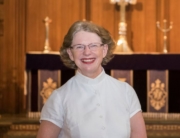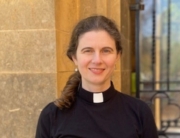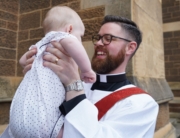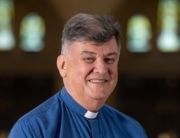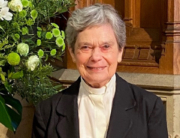Preacher: The Rev’d Canon Jenny Wilson, Precentor
In the name of God, creating, redeeming, sanctifying, … Amen.
Last Friday Evening in this Cathedral, in a most moving liturgy, former Archbishop Jeffrey Driver laid up his staff on the high altar, knelt in prayer and then, with his wife Lindy, made his final walk out of the West Doors. This walk we believe and hope will be to a life of significant contribution to the intellectual and spiritual life of the Anglican Church in Australia, and in the church overseas, particularly in their beloved South Sudan. Bishop Jeffrey preached his sermon, exploring the passage from the prophet Ezekiel about the dry bones coming to life through the word and breath of God. He exhorted us as a diocese to believe ourselves to be capable of thriving, and encouraged us to know “who we are and whose we are.”
Knowing who we are and whose we are. A knowledge that we find, week by week, as we gather on our Sabbath to listen to and ponder the words of scripture, a knowledge that washes over us as we reach out our hands for a wafer of bread that is for us the Body of Christ, as we take a sip of wine, for us his Blood.
Knowing who we are and whose we are as people of God, a God who longs to know us and be known, a God who reaches out to us, speaks to us in self communication, in the Word made flesh, in Jesus the Word of God.
And so we find our identity each week, partly in reflecting on passages of scripture both from the scriptures of the Hebrew people and from the New Testament and particularly from the accounts of Jesus’ life on earth found in the Gospels. This year our focus is on the Gospel of Luke, this week a passage from chapter thirteen of that gospel, where we see a woman who has been crippled for eighteen years enter the synagogue and we see Jesus’ response to this woman. Immediately, we then see the response of the religious leaders to what takes place.
In just a few verses before the gospel passage we heard read this morning, Jesus speaks of eighteen people who were killed when the tower of Siloam fell on them. He is addressing the issue of suffering and particularly the suffering of the innocent. “Do you think that these eighteen who were killed by the falling of that tower were worse offenders than all the others living in Jerusalem?” he asks. (Luke 13:4) The connection of suffering and sin is not as simple as the crowd would have liked to have thought. Eighteen people killed by the falling of the tower of Siloam, a woman crippled for eighteen years. Those for whom Luke was writing, those listening to this gospel narrative, would have pricked up their ears. This sort of repetition was used for a purpose. There is a connection here. And when there is a connection in a gospel story, it is always about the ways of God and the ways of human beings. It is about who we are and whose we are.
“Do you think that these eighteen who were killed by the falling of that tower were worse offenders than all the others living in Jerusalem?” Jesus asks. Are the innocent, or those who are ordinary human beings who sin as we do, responsible for their suffering, does their sin cause their suffering? Let’s think a bit more deeply about that. Jesus is saying.
And so, as those listening to this narrative were wondering about this connection of sin and suffering, Luke recounts, a few verses on, this story of a woman who has been crippled for eighteen years. On a Sabbath day, this crippled woman walks into the synagogue where Jesus is teaching. She is bent over and is quite unable to stand up straight. When Jesus sees her, he calls her over and says, ‘Woman, you are set free from your ailment.’ When he has laid his hands on her, immediately she stands up straight and begins praising God (Luke 13:11-13). Sin, blame, seem to have nothing to do with it. Jesus sees and sets free a child of God.
When a person is bent over you cannot look at their face, cannot look into their eyes. Any way of relating to them is seriously hindered. And ignoring them is easy. And when the prevailing religious culture tells you that they are responsible for their ailment, any sense of responsibility for them evaporates. Those in the synagogue would get on with their praying, with their engaging with those who were teaching them the law and the prophets. This woman barely exists.
For Jesus, though, she exists.
Jesus does four things that embrace this crippled woman’s existence and sets her free. Firstly he sees her. Then he calls her over. And then he names her. “Woman,” he says. Finally he lays his hands on her naming her free from her ailment. Where in those four actions does God’s freedom for this woman come? Where would it come for us? For these gospel stories are not only about Jesus healing those who are physically crippled, though they are about that. We are all bent over, crippled in some way, in some situations. Our diocese was bent over and crippled when Bishop Jeffrey came. Communities, nations, our world exhibit profound signs of being crippled, bent over, possessed by some powerful negativity force – fear, selfishness, greed … in our case it was guilt.
The theologian John Shea, writes the following of Jesus’ encounter with the crippled woman:
[Jesus’] actions of calling [the woman] out, talking to her, touching her, and healing her are theologically motivated. He is doing what God has done from the beginning – freeing people from what oppresses them. What God told Moses to say to Pharaoh, God says throughout history – “Let my people go!”[1]
God frees people from what oppresses them. Where would God’s freedom come for us? Perhaps in being seen, perhaps that would be enough. Perhaps in being called to conversation with God. Freedom might come in our hearing God call our name. Perhaps in God’s hands laid upon us.
The religious leaders are indignant. They are indignant because Jesus has cured this crippled woman on the Sabbath. The day of rest when no work should be done. One leader addresses the crowd, ‘There are six days on which work ought to be done; come on those days and be cured, and not on the Sabbath day.’
Jesus does not argue with these leaders, he does not quote scripture or engage in logical debate. This Word of God, through whose very being God reveals God-self, tells a tiny story with the leaders as the key characters, engages the leaders’ imaginations, connects them with their own lives. 1‘You hypocrites! Does not each of you on the Sabbath untie his ox or his donkey from the manger, and lead it away to give it water? 16And ought not this woman, a daughter of Abraham whom Satan bound for eighteen long years, be set free from this bondage on the Sabbath day?’
They do not understand the Sabbath, these religious leaders. These students of the Torah should understand it but they don’t. For them the Sabbath is a law that constrains. For Jesus, the Sabbath, the seventh day of creation, the day of God’s rest, is the day of thriving, the day when God delights in creation. Who is crippled now, bent over now, we might wonder?
“Let my people go!” God cries through history. The Sabbath of all days is the day when God will let God’s people go, when Jesus will place God’s freedom for creation above all things.
“Know who you are and whose you are,” Bishop Jeffrey said, as he laid up his staff and entrusted the diocese of Adelaide to God, a diocese that was crippled and bent over, a diocese that he helped God restore to life. As we pray for God to bless and sustain Jeffrey and Lindy, and as we pray to God to bring us a new leader, let us remember our identity as people of God, a God who sees us, calls us, names us, and sets us free.
[1] John Shea The Relentless Widow p241

